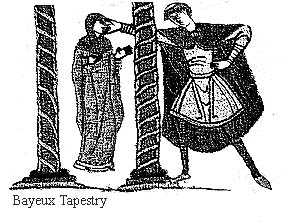 Welcome!
In this handout we will cover the following topics. I hope to get
to most of them in the class, but if not, feel free to contact me if
the
directions here don't make any sense to you. Contact info is at
the
end of the handout.
Welcome!
In this handout we will cover the following topics. I hope to get
to most of them in the class, but if not, feel free to contact me if
the
directions here don't make any sense to you. Contact info is at
the
end of the handout.
 Welcome!
In this handout we will cover the following topics. I hope to get
to most of them in the class, but if not, feel free to contact me if
the
directions here don't make any sense to you. Contact info is at
the
end of the handout.
Welcome!
In this handout we will cover the following topics. I hope to get
to most of them in the class, but if not, feel free to contact me if
the
directions here don't make any sense to you. Contact info is at
the
end of the handout.
The best suggestion, once you start looking at different types of garb, is to go to the library and find a general history of costume, and look at the styles there to see what you like. There are some caveats, however. Many of these compendiums are not particularly careful or reliable with the details of the costume; the costumes pictured are sometimes agglomerations of different elements from similar times, or drawings based on other drawings, which may not be accurate. Use such collections as a general indicator, and be certain to check books with period illustrations before starting construction of a new outfit.
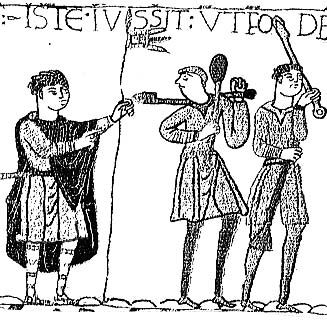 What
is worn:
What
is worn:If you've been to an SCA event, you'll notice many people in shirts or tunics that reach to the knee or longer, with long loose sleeves; worn over trousers or hose. Most medieval men wore knee or calf-length tunics over hosen. Athough the Norse wore something like trousers, they were wrapped tightly to the lower leg with fabric bands. Medieval women wore a long tunic (ankle length.) Both genders should have on a white under-tunic, which gets washed more than the overtunic, and headwear. SCA people tend to wear boots or floppy Chinese shoes; and the clothing is often decorated with trim at the neck, hem, sleeve end, and often biceps (over a seam that falls on the upper arm - no modern set-in sleeves). You'll notice that these generic SCA clothes are very similar to the clothes in the illustrations in this article.
So how do you construct something these garments? There are two very
easy ways to arrive at the basic "T" tunic. (So-called because when
laid
flat, the arms and the body form a T shape, unlike modern fitted
clothing,
which doesn't tend to have as much play in the arms.) The various
dress accessories are also relatively easy to construct, so let us
begin!
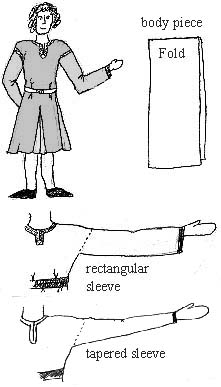 The
first, as illustrated here, is the most economical of fabric. It is
based
on rectangles and triangles; very easy to construct. As it happens,
it's
also fairly close to the method used in period for these garments. It
is
difficult to describe this method in print, but easy to construct once
you know what to do. Check out this other description of how
to make this tunic, with an automatic measurement calculator.
Note that sleeves and gores were the same fabric as the body of the
tunic.
The
first, as illustrated here, is the most economical of fabric. It is
based
on rectangles and triangles; very easy to construct. As it happens,
it's
also fairly close to the method used in period for these garments. It
is
difficult to describe this method in print, but easy to construct once
you know what to do. Check out this other description of how
to make this tunic, with an automatic measurement calculator.
Note that sleeves and gores were the same fabric as the body of the
tunic.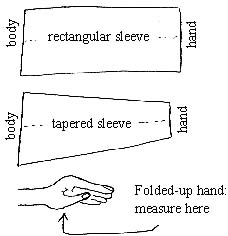
For the body of the garment, you will have a rectangle that reaches from your shoulders to the knee (or to the ground, depending what you want.): Take a measurement of yourself at your widest point (chest or hips). Add four inches for comfort. This is the width of your body panel.
Have a friend measure the length for you; if you're doing it yourself, there's a good chance that you'll measure incorrectly as you try to see what the number is. Add extra for a hem, or don't add extra if you plan to finish the hem with bias tape. You can either cut two of these rectangles out of the fabric, or you can cut one long rectangle out of the fabric, so you don't have the shoulder seams. If you're not making shoulder seams, mark the halfway point with a small snippet at the halfway point.
Now we cut out the sleeves, which are also rectangles. Take one end of your body rectangle, and lay it across your shoulders along the top, so you can see where the edge will come over your upper arm. Measure from that point to your wrist, and add seam allowance. This will be the length of your sleeve.
Measure around your upper arm, and take that measurement, plus 2" and seam allowance, for the width of the sleeve.
If you wish to have a tapered arm, also take a measurement around the broadest part of your hand as it would be scrunched for getting through a tight sleeve, not as it lies normally.
Add the same amount of seam allowance, and this will be the measurement for the wrist end of your sleeves.
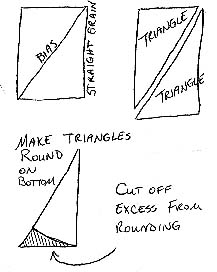 Now,
the more complex bit: The extra gores (triangles) that are added to the
garment to form the skirt. These usually are set in starting at the
waist,
but also can be started higher on the body if you wish. These
should
be of the same fabric as the rest of the tunic.
Now,
the more complex bit: The extra gores (triangles) that are added to the
garment to form the skirt. These usually are set in starting at the
waist,
but also can be started higher on the body if you wish. These
should
be of the same fabric as the rest of the tunic.
Find the point on your body where you wish for the gores to start. Measure from their to your designated hemline, taking into account any extra length added for hem allowance. This measurement becomes the radius or side dimension of the triangles we are going to make to set in.
You will need eight triangles. Two each for each side, and for center front and center back. The bottom edge of the triangles will vary depending on how much fabric you have left, but in general, aiming for a bottom measurement of appx 10" will be sufficient.
One side of the triangle will be on the straight grain of the fabric, and one on the bias. You will need to even out the length along the bias so that your triangles become circle-segments; do this by folding each triangle once or twice and then cutting across evenly, from the shortest side. Lastly, the neck hole must be cut. It is easiest to do this before any other sewing begins.
"Keyhole" necklines are easy to do, and very accurate for this type
of garment. You can either cut it out and edge it with bias tape, or
you
can make a facing for it, sew the facing on, and then cut it out. I
prefer
the bias tape method, because it doesn't allow little bits of facing to
stick out at odd times, and produces a smoother look.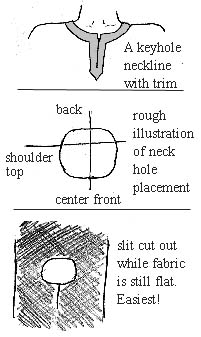
Although humans vary in the shape of their necks, generally a squashed circle will do very well as a neckline.
The lines in this drawing show the center meridian of the body and the shoulder line in relation to the placement of the neck.
Measure around your neck and fiddle with the squashed circle shape until you have one that looks like it will work for you.
You should also determine the depth of the slit in the front. Take the difference between your neck measurement and your head measurement; divide in half. This is the minimum amount of slit that you will need to get the opening over your head. You may make it longer if you like, of course. Cut it along the grain of the fabric, in front, paying attention to the weave so that the cut is guaranteed to be straight.
Finish the edge however you prefer; bias tape is a good choice. You can either start the bias tape at the center back, or at the bottom of the slit (see the illustration.)
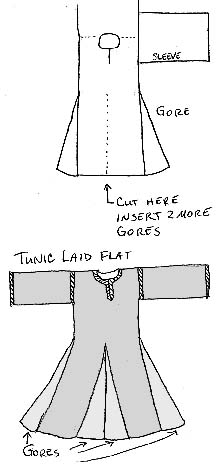 If
you're going to put trim around the neckline, now, when it is flat, is
the easiest time. To fit flat trim to a round neckline, sometimes it is
easiest to gather the trim with a drawstring at the neck, sew down the
gathers on the inner edge, and sew it flat on the outer edge. Other
times,
it looks best to pleat the inner edge to take up the fullness.
You could also edge it with bias tape in a similar, or a contrasting
color, or embroider the edge.
If
you're going to put trim around the neckline, now, when it is flat, is
the easiest time. To fit flat trim to a round neckline, sometimes it is
easiest to gather the trim with a drawstring at the neck, sew down the
gathers on the inner edge, and sew it flat on the outer edge. Other
times,
it looks best to pleat the inner edge to take up the fullness.
You could also edge it with bias tape in a similar, or a contrasting
color, or embroider the edge.
Now that the neck is done, sew the sleeves to the body. If you're going to put trim over this seam, now is the easiest time to do so -- when it's laid out flat. Likewise, putting trim on the sleeve cuffs is easiest at this time.
Next sew the gores to the body, as shown, with the bias edge matched
to the straight grain of the body. See the picture; you'll have two
gores
on each side of the body pieces. Note: the gores (godets) are shown a
different color in the "laid flat" drawing. This is only for
contrast; all evidence points to gores being of the same fabric as the
rest of the garment.
The next step is a little complex, but worth it. Cut a slit up the middle front and middle back of the body pieces, from the hem to the same height as the other gores. This is where you will insert the remaining gores. Sew them in, like the ones on the sides, with the bias edge of the gore against the straight grain of the slit.
You're almost done. Now all you need to do is sew the gores together along their bias edges, front, back, and sides, and sew the underside of the sleeve, and the upper body seam.
You're done! Now all you need to do is hem it and trim any of it
that
you wish to! (remember that it is easiest to trim neck and arm seams
before
you sew the side seams.)
Mostly it seems that the hems were not embellished in the middle ages.
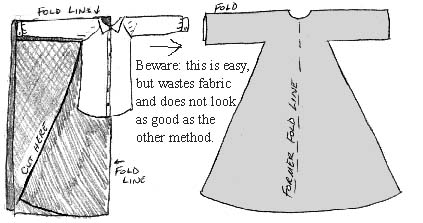
You can insert gores in the center front and center back to more
closely
approximate the period method described above. This will make the
skirts hang much better.
Many people find cotton to be an economical choice, but be advised
that
you'll be happier in pure cotton than in polyester-cotton blends. The
weaves
used, even early in our period are often quite complex. One of the most
popular for the upper classes was a diamond-patterned twill; the
pattern
of the weave makes diamond shapes, somewhat like a squashed grid, in
the
fabric. In general, a woven geometric pattern that is symmetrical will
look believable. Colors varied greatly, so you don't have to worry too
much about that for your first few outfits. Much later in period,
colors
became more codified, but for the most part, that doesn't happen until
the late Renaissance. Wear the colors that you want to, and avoid
florescent
hues unless you're very certain you know what they used!
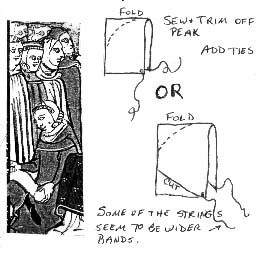 Once
you've got your tunic done, the next most useful thing to own is some
kind
of headwear. Not only does it protect your head from the sun or the
cold,
but it keeps off random tourney dust and helps avoid tangles.
Once
you've got your tunic done, the next most useful thing to own is some
kind
of headwear. Not only does it protect your head from the sun or the
cold,
but it keeps off random tourney dust and helps avoid tangles.
See the other handouts on hood construction or coif and/or snug cap if you want more detail. The close fitting cap is easily made out of a folded piece of fabric which has been sewn with a curve across the back, as shown, and ties attached to the ends to fasten under the chin. It is going to wrinkle along the upper seam; my understanding is that the 3-piece caps were only very late in period, but they solve this characteristic.
Often these were white, but I have seen illustrations of this in
both
green and red; there may have been other colors in use.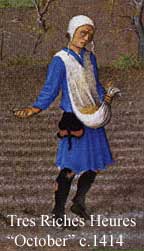
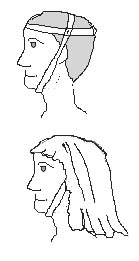 Women's
veils were circles of white cloth (usually linen) held on with bands of
the same fabric. I have not yet seen any other color than white used as
a veil in the illustrations for this time period, although many people
like to have different colored veils. Use opaque lightweight fabric; a
good cotton if you don't have a source for white linen. Opaque fine
silk
would work well also.
Women's
veils were circles of white cloth (usually linen) held on with bands of
the same fabric. I have not yet seen any other color than white used as
a veil in the illustrations for this time period, although many people
like to have different colored veils. Use opaque lightweight fabric; a
good cotton if you don't have a source for white linen. Opaque fine
silk
would work well also.
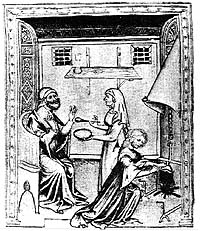 Later
in period there are apparently records of veils with dyed bands of
color
along the margins, but I do not have a good source for that either. It
does produce an interesting effect, as does beading the edge, another
common
mostly-modern variant.
Later
in period there are apparently records of veils with dyed bands of
color
along the margins, but I do not have a good source for that either. It
does produce an interesting effect, as does beading the edge, another
common
mostly-modern variant.
Sometimes veils were square and used as a shawl over the tops of the shoulders, but for ease of wear until you are used to them, I recommend a round veil, about 1' in radius (ie, 2' diameter).
The bands that hold the veil on are thin strips, about 1" wide, and about a foot and a half long, depending on your head size.
Fasten the first one with a straight pin under your chin and passing over the top of your head, just forward of your ears, and not over the highest part of the back of your head. This one will resist the downward and backward weight of the veil itself.
Pin the next one across your forehead, circling your head parallel to the ground. Fasten it also to the chin band where they cross.
Now you have a secure base for your veil, which will ensure that it
does not fly off in the wind, or as you do things. The veil is then
pinned
to the bands at the center front, center top, and the sides where it
lies
over the crossed bands over your ears. If you have the time, many
people
like to make pleats in the veil at the temple, to provide a little
ruffling/fullness
effect.
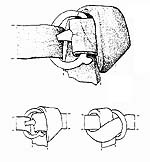 Belts
during this time period are not particularly complex. For the most
part,
a belt a few inches longer than your waist, with a simple buckle, will
do just fine, especially for men. Such a belt would not have a "keeper"
-- that little circle of leather meant to keep the extra belt length
smooth
along the belt on your body. The picture is from the book Dress
Accessories and shows a belt fragment, still in a knot, with
buckle
and all, that was dug up from a medieval trash dump.
Belts
during this time period are not particularly complex. For the most
part,
a belt a few inches longer than your waist, with a simple buckle, will
do just fine, especially for men. Such a belt would not have a "keeper"
-- that little circle of leather meant to keep the extra belt length
smooth
along the belt on your body. The picture is from the book Dress
Accessories and shows a belt fragment, still in a knot, with
buckle
and all, that was dug up from a medieval trash dump.
Many people in the SCA wear belts that have a long tongue hanging down from the belt at the buckle. I haven't found a good illustration of this style in the early period, but if you want to wear this style, make sure that you 1: use a belt with a real buckle, and then loop the extra "behind" the buckle area so it will hang straight, and 2: don't wear a belt whose tongue hangs below the hem of your tunic.
You can buy such belts in almost any menswear department, out of many substances that resemble leather. If you want one that hangs down, shop in the Large Men's or Large Women's departments or stores; they sell sizes that will give you more than enough length for the fashion statement that you want. You may have to punch extra holes in these, though.
Making such a belt is easy, if you don't want to shop for one. Go to the fabric store and buy the appropriate length of "Belt Interfacing" which is a plastic product meant to be the guts of a fabric belt. Buy a suitable buckle, fabric to cover it (black heavy cotton is good) and a few "brass drapery rings," which can be bought from a good fabric or upholstery store. They are about 1/2" across, and solid -- no butted or overlapped ends.
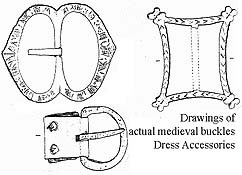 Sew
the fabric into a tube that is 1/4" larger than the interfacing, and
about
3" longer than the interfacing. Turn this inside out, so the seam
doesn't show. Insert the belt facing into the tube, leaving about
1" of extra fabric at the non-buckle end. Fiddle with the tube so
that the seam runs along the "inside" of the belt facing, where it
won't
show when you're wearing the belt.
Sew
the fabric into a tube that is 1/4" larger than the interfacing, and
about
3" longer than the interfacing. Turn this inside out, so the seam
doesn't show. Insert the belt facing into the tube, leaving about
1" of extra fabric at the non-buckle end. Fiddle with the tube so
that the seam runs along the "inside" of the belt facing, where it
won't
show when you're wearing the belt.
Starting at the non-buckle end, roll the belt up very loosely; about the size of your waist, maybe a bit smaller. When you get to the end that the buckle will be attached to, put a pin through both the belt fabric and the interfacing, and let it unroll. This will allow a little ease in the belt for stretching of the plastic, and for the effects of converting a straight bit of plastic to a belt that encircles something. Sew the buckle to the belt, making sure to go through the plastic a few times in the process. Any bad stitching will be hidden by the rest of the belt; don't worry here. Don't forget to cut a little hole for the buckle prong itself.
Put the belt on. Figure out where the best spot would be for the hole you will use most often; make a mark there. Also add two more marks on either side, about an inch apart, for variations in clothing thickness.
Using a leather needle, take one of the brass drapery rings, and sew it securely to the belt, going through both the plastic and the layers of fabric. This will ensure that your belt will not tear under heavy use (it is plastic, after all.) Either sew these to the underside, or to the top; but if you sew the rings to the top, be prepared to cover any shiny bits with more sewing thread.
Now cut (with an exacto knife or hole punch) the holes inside of the reinforcement, and make sure that the tail end of the belt looks good. You're done!
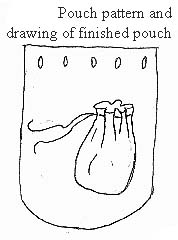 The
other thing that is very, very useful for SCA garb is a belt pouch.
Although
I suspect that carrying stuff around with oneself didn't become
particularly
important until life became more complex in the 1300s, we here in the
modern
world need something to carry our authorization cards, driver's
license,
car keys, etc. The belt pouch is one way to accomplish
this.
Most illustrations of belt pouches show them hanging around the knee to
lower thigh area of the wearer. In the 1400s, noble women are
rarely
shown with pouches, but the occasional illustration may say why: they
wore
them between their outer garment and their next-inward garment, usually
below the knee. Surprisingly, it doesn't whomp on your legs when
you're walking.
The
other thing that is very, very useful for SCA garb is a belt pouch.
Although
I suspect that carrying stuff around with oneself didn't become
particularly
important until life became more complex in the 1300s, we here in the
modern
world need something to carry our authorization cards, driver's
license,
car keys, etc. The belt pouch is one way to accomplish
this.
Most illustrations of belt pouches show them hanging around the knee to
lower thigh area of the wearer. In the 1400s, noble women are
rarely
shown with pouches, but the occasional illustration may say why: they
wore
them between their outer garment and their next-inward garment, usually
below the knee. Surprisingly, it doesn't whomp on your legs when
you're walking.
The basic belt pouch can be made out of leather or fabric. Both versions work easiest using a simple U shape of material, sewn along the bottom and edges, and with a drawstring at the top. If you are inclined to get fancy, you can line it or decorate it.
A later version was certainly worn by men and is also easy to
make.
Take a rectangle of material (I suggest about 7x14"); fold it and sew
up
the sides. Finish the top edge if necessary.
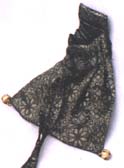
In the center back, sew a finished loop of material to make a belt loop -- finished dimensions of the loop should be about 2" wide by a little longer than twice the width of your belt. Sew it to the pouch firmly at the bottom of the loop and also at the top edge of the pouch.
Sew or cut a flat strip of material that is twice the width of the
pouch,
plus a little extra. (If you're using fabric, you can do this as
a tube.) Cut slits in the pouch to take this drawstring; four on the
front
and four on the back. Be symmetrical with this (same placement
front
and back.) Finish the holes as you see best; (Fray Check is one option;
buttonholes another) and thread the drawstring through the holes.
If you pull the drawstring up slowly, it will gather in a pleated
manner
that looks really cool, and very much like the picture here.


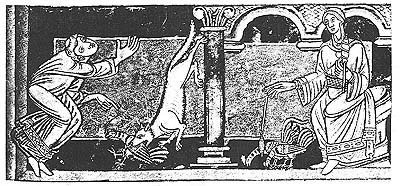
| All material © 1999-2001 Cynthia Virtue | Email Author with comments |
| Back to Virtue Ventures Main Page | Back to Article Index |